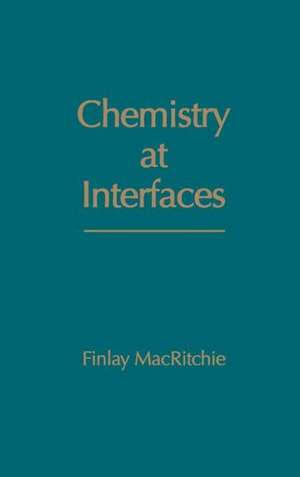Chemistry at Interfaces
Autor Finlay MacRitchieen Limba Engleză Hardback – 2 apr 1990
Preț: 436.88 lei
Preț vechi: 567.38 lei
-23% Nou
Puncte Express: 655
Preț estimativ în valută:
83.60€ • 89.39$ • 69.70£
83.60€ • 89.39$ • 69.70£
Carte tipărită la comandă
Livrare economică 18 aprilie-02 mai
Preluare comenzi: 021 569.72.76
Specificații
ISBN-13: 9780124647855
ISBN-10: 0124647855
Pagini: 283
Dimensiuni: 152 x 229 x 18 mm
Greutate: 0.56 kg
Ediția:New.
Editura: ELSEVIER SCIENCE
ISBN-10: 0124647855
Pagini: 283
Dimensiuni: 152 x 229 x 18 mm
Greutate: 0.56 kg
Ediția:New.
Editura: ELSEVIER SCIENCE
Cuprins
Preface
1. Introduction
2. Theoretical Concepts I
I. What Makes a Reaction Go?
II. Quantitative Measurements of Free Energy
III. Application of Thermodynamic Principles to Interfacial Phenomena
IV. The Hydrophobic Effect
Demonstrations
Problems
References
3. Theoretical Concepts II
I. The Distribution of Molecules
II. Quantum Energy Levels and Partition Functions
III. Principle of Independent Surface Action
IV. Important Intensive Properties for Interfaces
V. Distribution of Molecules between Bulk and Interface
VI. Effects of an Interface on the Orientation of Molecules
VII. Reaction Rates at Interfaces
Demonstrations
Problems
References
4. The Film Balance and the Measurement of Interfacial Pressure
I. The Problem of Purity in Interfacial Work
II. The Film Balance
III. Modifications to Basic Film Balance
IV. Spreading of Monolayers
Demonstrations
Problem
References
5. Additional Techniques I
I. Interfacial Potential
II. Interfacial Rheology
III. Transfer of Films to Solid Supports
IV. Radioactive Tracers
Demonstrations
Problems
References
6. Additional Techniques II
I. Optical Techniques
II. Solid/Fluid Interfaces
III. Forces between Surfaces
Demonstrations
Problem
References
7. Monolayers
I. Monolayer States
II. The Clausius-Clapeyron Equation
III. Equilibrium Spreading Pressure
IV. Effects of Systematic Change of Molecular Structure on Monolayer Properties
V. Monolayers at the Oil/Water Interface
VI. Monolayers of More Complex Molecules
Demonstration
Problems
References
8. Physical Processes at Interfaces
I. Adsorption
II. Desorption
III. Spreading or Two-Dimensional Dissolution
IV. Precipitation of Monolayers
V. Molecular Configurational Changes
VI. Surface Flow
VII. Transport across Interfaces
VIII. Unidimensional Interfaces
IX. General Summary
Demonstrations
Problems
References
9. Chemical Reactions
I. Kinetics of Reactions Studied by the Film Balance
II. Specific Reactions Studied in Monolayers
III. Polymerization Reactions
IV. General Features of Interfacial Reactions
V. Design of Functionalized Monolayer Systems
VI. Unidimensional and Zero-Dimensional Reactions
Demonstrations
Problem
References
10. Biological Processes and Reactions
I. Membrane-Mimetic Chemistry
II. Enzyme Reactions at Interfaces
III. Direct Studies on Model Membrane Systems
IV. The Pulmonary Surfactant
V. Thrombogenicity
Demonstrations
Problem
References
11. Applications and Future Directions
I. Biology and Medicine
II. Industrial Applications
III. New Technologies
References
Appendix
Answers to Problems
Index









